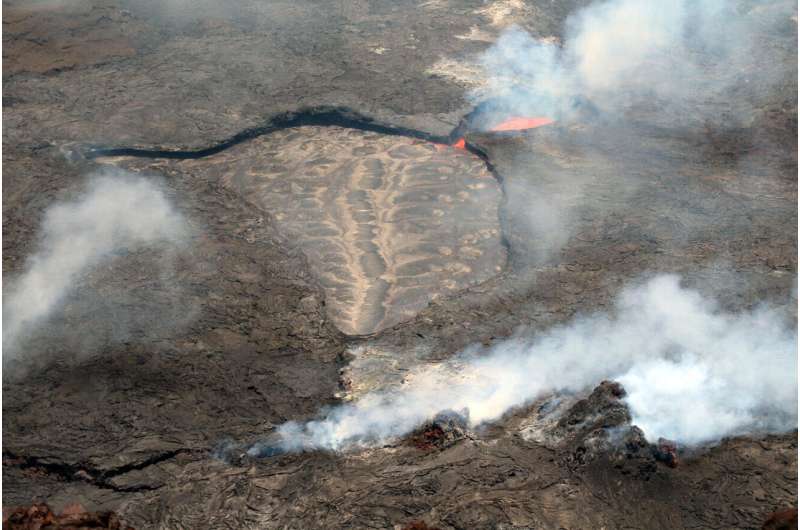This article has been reviewed according to Science X's editorial process and policies. Editors have highlighted the following attributes while ensuring the content's credibility:
fact-checked
peer-reviewed publication
trusted source
proofread
New research shows the Kīlauea volcano erupted like a stomp-rocket in 2018

No two volcanic eruptions are exactly alike, but scientists think a series of explosive eruptions at Kīlauea volcano fit into a whole new category.
By analyzing the dynamics of 12 back-to-back explosions that happened in 2018, researchers describe a new type of volcanic eruption mechanism. The explosions were driven by sudden pressure increases as the ground collapsed, which blasted plumes of rock fragments and hot gas into the air, much like a classic stomp-rocket toy.
Researchers from the University of Oregon, United States Geological Survey and China's Sichuan University report their findings in a paper published May 27 in Nature Geoscience.
The particular string of explosions at the summit of Kīlauea was part of a sequence of events that included lava flows erupting from lower on the flank of the volcano. Those lava flows destroyed thousands of homes and displaced residents on the Island of Hawai'i for months.
Understanding exactly what happened in past volcanic eruptions, colloquially called "hindcasting," allows volcanologists to make better forecasts about future eruptions and give more accurate warnings to people in an eruption's path.
For the most part, explosive volcanic eruptions are either primarily driven by rising magma, vaporized groundwater, or some combination of the two, according to Josh Crozier, who did this research as a doctoral student at the UO. But these eruptions didn't quite fit the mold.
"These eruptions are quite interesting in that they don't really seem to involve either of those," Crozier said. "The eruptive material contained very little that looked like fresh magma that was blasted out, but there's no evidence for significant groundwater being involved, either."
The Hawaiian Volcano Observatory, part of the U.S. Geological Survey, keeps close tabs on Kīlauea. The volcano is covered with scientific instruments, from ground sensors that measure the shaking of the earth to tools that analyze the gases released from the volcano.
"A cool thing about these eruptions is that there were a bunch of them in sequence that were remarkably similar; that's relatively unusual," said Leif Karlstrom, a volcanologist at the UO. "Typically, volcanic eruptions don't happen with as much regularity."
So the team had more data than usual to work with, and they could dig deeper into the specific dynamics of the eruptions.
Putting all that data into a variety of atmospheric and subsurface models, the scientists pieced together a new story about what happened on Kīlauea during the string of events in 2018.
Before each explosion at the summit, magma was slowly draining from an underground reservoir. (This magma was feeding lava flows 40 kilometers away, on the eastern flank of the volcano.) As the reservoir depleted, the ground above it—the crater within the caldera at the volcano's summit—suddenly collapsed.
That quickly increased the pressure in the reservoir. And because there was a pocket of accumulated magmatic gas sitting at the top of this reservoir, the pressure increase squeezed the magmatic gas and bits of rubble through a conduit and blasted them out of a vent in Kīlauea's crater.
The researchers compare the eruption dynamic to a stomp-rocket toy, where stepping on an air bag connected to a hose launches a projectile into the air.
"The 'stomp' is this whole kilometer-thick chunk of rock dropping down, pressurizing the pocket, and then forcing material directly up," Crozier said. "And the 'rocket' is, of course, the gas and rocks erupting from the volcano."
Caldera collapse is fairly common, Crozier notes. So while this is the first time scientists have specifically spelled out this specific stomp-rocket mechanism, it's probably not the only time it's occurred.
The study was able to link geophysical observations to the properties of the volcanic plume in the atmosphere.
"This link is very rare," said Joe Dufek, a volcanologist at the UO. "It points to new ways for us to observe eruptions and to combine sensor measurements with computer simulations to better assess hazards from eruptions."
The fact that this was a series of smaller eruptions may have made it easier to see the underlying mechanism, Dufek said. Other complex processes weren't overshadowing the stomp-rocket component.
But that's not to say that Kīlauea is simple. A typical textbook drawing of a volcano shows magma moving upwards through chambers at different depths. But it's rarely that straightforward, and a volcano like Kīlauea, decked out in scientific instruments, provides an opportunity to dig into the details.
"This is an example, and there's an increasing number of these, where the pathways of magma ascent are quite geometrically complex," Karlstrom said. "It gives us a much more nuanced picture of what volcanic plumbing systems look like."
More information: Josh Crozier, Explosive 2018 eruptions at Kīlauea driven by a collapse-induced stomp-rocket mechanism, Nature Geoscience (2024). DOI: 10.1038/s41561-024-01442-0. www.nature.com/articles/s41561-024-01442-0
Journal information: Nature Geoscience
Provided by University of Oregon


















